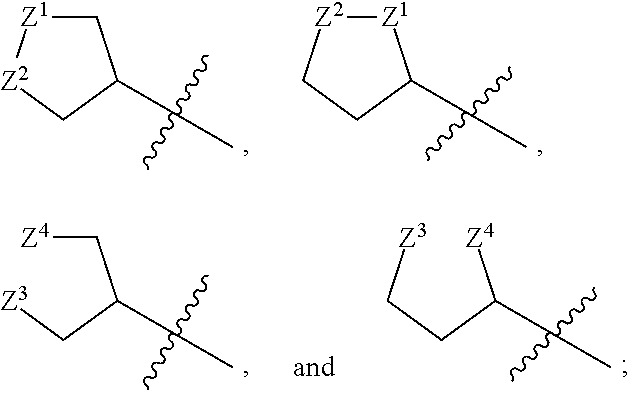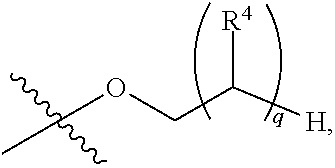1,2-dithiolane and dithiol compounds useful in treating mutant egfr-mediated diseases and conditions
a technology of dithiol and dithiol, which is applied in the field of 1, 2dithiolane and dithiol, can solve the problems of large global cancer burden, aggressive lung cancer, and significant treatment challeng
- Summary
- Abstract
- Description
- Claims
- Application Information
AI Technical Summary
Benefits of technology
Problems solved by technology
Method used
Image
Examples
example 1
lthio)methyl)acrylic acid
[0248]
[0249]To a stirred suspension of 2-(bromomethyl)acrylic acid (8.0 g, 49 mmol) in water (160 mL) was added a solution of Na2CO3 (9 g in 32 mL of water) in small portions at 0° C. To the resulting solution was added thiolacetic acid (3.5 mL) and stirred at 0° C. for 30 minutes. The solution was acidified with concentrated hydrochloric acid to pH 1. The residue was extracted with ethyl acetate (3×500 ml). The combined extracts were dried over anhydrous Na2SO4 and evaporated to dryness to furnish the desired crude product. The pure product was obtained by column chromatography on silica gel (100-200 mesh) eluting with 5% (v / v) ethyl acetate in hexanes as a white solid (3.7 g, yield 47%). 1H-NMR (300 MHz, CDCl3): δ 8.35 (bs, 1H), 6.40 (s, 1H), 6.03 (s, 1H), 3.80 (s, 2H), 2.34 (s, 3H).
example 2
thio)-2-((acetylthio)methyl)propanoic acid
[0250]
[0251]Method A. A mixture of 2-((acetylthio)methyl)acrylic acid (3.50 g, 21.9 mmol) in thiolacetic acid (3.1 mL) was stirred at room temperature for 16 hours. The reaction mixture was concentrated at reduced pressure to remove the thiolacetic acid and purified by column chromatography on silica gel (100-200 mesh) eluting with 10% (v / v) ethyl acetate in hexanes to produce the product as colorless liquid (2.3 g, yield 45%). 1H-NMR (300 MHz, CDCl3): δ 7.27 (bs, 1H), 3.24-3.14 (m, 4H), 2.93-2.89 (m, 1H), 2.35 (s, 6H).
[0252]Method B. A mixture of 3-bromo-2-(bromomethyl)propanoic acid (12.0 g, 48.9 mmol) in 46 mL water containing 3.2 g of KOH was cooled to 0° C. Thioacetic acid (7.5 mL, 102 mmol) was added dropwise and the resultant solution was stirred for 5 minutes before the slow addition of a solution containing 6.8 g of KOH in 61 mL water. The reaction mixture was heated for 12 hours at 110° C. then cooled to 0° C. and carefully acidifi...
example 3
ulfanyl-propionaldehyde
[0253]
[0254]To a solution of benzylmercaptan (6.80 mL, 101 mmol) in dichloromethane (150 mL) was added acrolein (9.45 mL, 80.0 mmol) dropwise at 0° C. The resulting solution was allowed to warm up to room temperature and stirred for 2 hours. Dichloromethane was evaporated in vacuo and the residue was purified by flash column chromatography (silica gel, Ethyl acetate:hexanes, 2:98) to afford the desired compound as colorless liquid (13 g, yield 91%). 1H-NMR (300 MHz, DMSO-d6): δ 9.60 (s, 1H, CHO), 7.32-7.22 (m, 5H), 3.74 (s, 2H), 2.71-2.60 (m, 4H).
PUM
| Property | Measurement | Unit |
|---|---|---|
| pH | aaaaa | aaaaa |
| pH | aaaaa | aaaaa |
| temperature | aaaaa | aaaaa |
Abstract
Description
Claims
Application Information
 Login to View More
Login to View More - R&D
- Intellectual Property
- Life Sciences
- Materials
- Tech Scout
- Unparalleled Data Quality
- Higher Quality Content
- 60% Fewer Hallucinations
Browse by: Latest US Patents, China's latest patents, Technical Efficacy Thesaurus, Application Domain, Technology Topic, Popular Technical Reports.
© 2025 PatSnap. All rights reserved.Legal|Privacy policy|Modern Slavery Act Transparency Statement|Sitemap|About US| Contact US: help@patsnap.com



